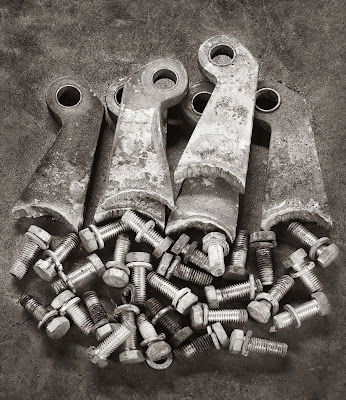Ever had the experience of discovering the work of a previously unknown to you photographer and you see some really awesome images. This can be a bit of a mixed blessing. It's always great to look at really good photographs, but it does come at a price.
First, there's the thought that perhaps this person is better than we are.
Second, they take photographs like I take so what does that say about the work I'm doing - am I wasting my time?
Third, now that I have seen their work, does that mean I can't go out and take similar photographs for fear I'm plagiarizing?
and Fourth, what if they have been more successful than me - more shows - more publications - perhaps a book or two?
Perhaps you are an amateur photographer of not a lot of experience and have yet to get into print. You are reading my blog and looking at my images, thinking some of the above about me and my work. Well guess what, I'm doing the same thing when I look at the work of others. It's not that I'm jealous of the success of others, just insecure about my own place in the scheme of things, and no matter how many nice comments I receive, no matter how much success comes my way, there's still that nagging doubt. No matter how high we climb, there's another ridge above us.
Now, it may not necessarily be entirely or even mostly a bad thing. Insecurity can drive us to try harder, though the risk is we may give up in despair.
I would like to address each of the above issues.
One - They are better.
Well, do you really want to look at the work of photographers who are worse than you? If we are to improve, from whom are we to learn? The idea that we can improve in a vacuum is pretty far fetched, we improve because we see that there is more to be achieved. We need goals and who better to suggest those goals than the people who have gone before us, even if it was yesterday afternoon at 3:30?
Two They're already doing the work I want to do.
I could decide to give up. For example I have put a lot of energy into my Independent Machinery project. Viewing the latest Lenswork Extended I saw for the first time a much larger selection of Brook's images from "Made Of Steel" and frankly, there is coniderable overlap between his images and mine, and I did think for a little while, "Gee, he's already done this stuff so is there really a need for more of same?" Fortunately several things came to mind.
a) absolutely no subjects are new in photography - they have all been done before, so we might as well relax and simply do the best we can.
b) unless we have done all our learning from a single photographer, it's almost impossible for us to see the world exactly the same way as any other photographer - rather like fingerprints - our eye is unique.
c) the odds are that even if we saw someone else's work and decided to copy it, the odds are excellent that we'd be distracted on the way by other things. Certainly that was my experience with each visit to Independent Machinery. Based on the previous trip, there would be something I'd plan to do this time, only to be distracted by far more interesting things and more often than not, the original plan is forgotten - so if I get distracted from my own plans, odds are darn good anyone is likely to be distracted from the work of another.
Three - Am I plagiarizing?
It's true that if we see a good idea that we haven't previously thought of, it's a little awkward then running out and copying them. Using Lenswork again, the most recent issue has albumin prints of fruit. Perhaps I shouldn't photograph fruit - but people have been photographing fruit since cameras were invented, and using albumin may be unusual these days but certainly in the history of things is most definitely not unique. There are images of the new Disney Theatre. Do we really believe that there are no more images to be taken of this building, that there's nothing more to be said, that adding our vision to the project won't add anything? I doubt we could be that unimaginative. There are images from New Orleans, but we have seen lots of essays of New Orleans since Katrina and frankly, they all looked quite different from each other, and keeping New Orleans in the national mind is a good thing so hopefully there will be many more to come.
and Four - They appear to be more successful.
There are several points to be made here.
a) Success and excellence are not synonymous.
b) If they are more successful, then perhaps there is something to be learned?
c) Success often comes at a price - schlepping your work round dozens of galleries, dealing with multiple rejections, making, packaging and shipping your work (and getting it back damaged (if at all). It might mean sacrificing career or family, exercise or other measures of quality of living - do you really want to be a "starving artist"?
d) If their success is well deserved, well isn't that wonderful it's nice to see good work rewarded and perhaps our turn will come some day.
And that's my thoughts on discovering some really good work. Great, terrific, glad to see it. I will continue to point out impressive work as and when I discover it.






















